Related Research Articles

Allergies, also known as allergic diseases, refer to a number of conditions caused by the hypersensitivity of the immune system to typically harmless substances in the environment. These diseases include hay fever, food allergies, atopic dermatitis, allergic asthma, and anaphylaxis. Symptoms may include red eyes, an itchy rash, sneezing, coughing, a runny nose, shortness of breath, or swelling. Note: food intolerances and food poisoning are separate conditions.

Rhinitis, also known as coryza, is irritation and inflammation of the mucous membrane inside the nose. Common symptoms are a stuffy nose, runny nose, sneezing, and post-nasal drip.
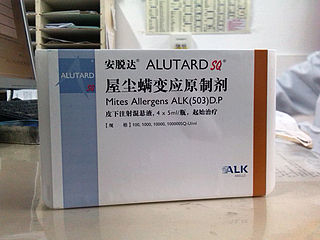
Allergen immunotherapy, also known as desensitization or hypo-sensitization, is a medical treatment for environmental allergies, such as insect bites, and asthma. Immunotherapy involves exposing people to larger and larger amounts of allergen in an attempt to change the immune system's response.

The interleukin 4 is a cytokine that induces differentiation of naive helper T cells (Th0 cells) to Th2 cells. Upon activation by IL-4, Th2 cells subsequently produce additional IL-4 in a positive feedback loop. IL-4 is produced primarily by mast cells, Th2 cells, eosinophils and basophils. It is closely related and has functions similar to IL-13.
Acute severe asthma, also known as status asthmaticus, is an acute exacerbation of asthma that does not respond to standard treatments of bronchodilators (inhalers) and corticosteroids. Asthma is caused by multiple genes, some having protective effect, with each gene having its own tendency to be influenced by the environment although a genetic link leading to acute severe asthma is still unknown. Symptoms include chest tightness, rapidly progressive dyspnea(shortness of breath), dry cough, use of accessory respiratory muscles, fast and/or labored breathing, and extreme wheezing. It is a life-threatening episode of airway obstruction and is considered a medical emergency. Complications include cardiac and/or respiratory arrest. The increasing prevalence of atopy and asthma remains unexplained but may be due to infection with respiratory viruses.
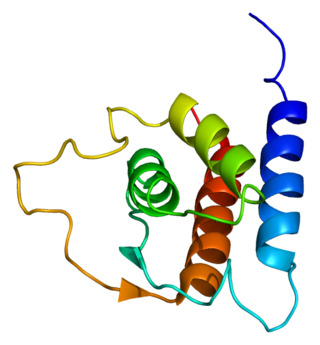
Interleukin 13 (IL-13) is a protein that in humans is encoded by the IL13 gene. IL-13 was first cloned in 1993 and is located on chromosome 5q31.1 with a length of 1.4kb. It has a mass of 13 kDa and folds into 4 alpha helical bundles. The secondary structural features of IL-13 are similar to that of Interleukin 4 (IL-4); however it only has 25% sequence identity to IL-4 and is capable of IL-4 independent signaling. IL-13 is a cytokine secreted by T helper type 2 (Th2) cells, CD4 cells, natural killer T cell, mast cells, basophils, eosinophils and nuocytes. Interleukin-13 is a central regulator in IgE synthesis, goblet cell hyperplasia, mucus hypersecretion, airway hyperresponsiveness, fibrosis and chitinase up-regulation. It is a mediator of allergic inflammation and different diseases including asthma.

Chemokine ligand 28 (CCL28), also known as mucosae-associated epithelial chemokine (MEC), CCK1 and SCYA28, is a chemokine. CCL28 regulates the chemotaxis of cells that express the chemokine receptors CCR3 and CCR10. CCL28 is expressed by columnar epithelial cells in the gut, lung, breast and the salivary glands and drives the mucosal homing of T and B lymphocytes that express CCR10, and the migration of eosinophils expressing CCR3. This chemokine is constitutively expressed in the colon, but its levels can be increased by pro-inflammatory cytokines and certain bacterial products implying a role in effector cell recruitment to sites of epithelial injury. CCL28 has also been implicated in the migration of IgA-expressing cells to the mammary gland, salivary gland, intestine and other mucosal tissues. It has also been shown as a potential antimicrobial agent effective against certain pathogens, such as Gram negative and Gram positive bacteria and the fungus Candida albicans.
Collectins (collagen-containing C-type lectins) are a part of the innate immune system. They form a family of collagenous Ca2+-dependent defense lectins, which are found in animals. Collectins are soluble pattern recognition receptors (PRRs). Their function is to bind to oligosaccharide structure or lipids that are on the surface of microorganisms. Like other PRRs they bind pathogen-associated molecular patterns (PAMPs) and danger-associated molecular patterns (DAMPs) of oligosaccharide origin. Binding of collectins to microorganisms may trigger elimination of microorganisms by aggregation, complement activation, opsonization, activation of phagocytosis, or inhibition of microbial growth. Other functions of collectins are modulation of inflammatory, allergic responses, adaptive immune system and clearance of apoptotic cells.

CCL17 is a powerful chemokine produced in the thymus and by antigen-presenting cells like dendritic cells, macrophages, and monocytes. CCL17 plays a complex role in cancer. It attracts T-regulatory cells allowing for some cancers to evade an immune response. However, in other cancers, such as melanoma, an increase in CCL17 is linked to an improved outcome. CCL17 has also been linked to autoimmune and allergic diseases.

Chemokine receptor 6 also known as CCR6 is a CC chemokine receptor protein which in humans is encoded by the CCR6 gene. CCR6 has also recently been designated CD196. The gene is located on the long arm of Chromosome 6 (6q27) on the Watson (plus) strand. It is 139,737 bases long and encodes a protein of 374 amino acids.
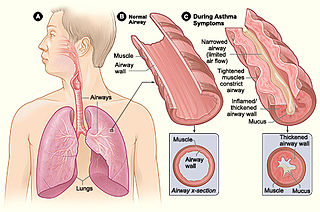
Asthma is a common pulmonary condition defined by chronic inflammation of respiratory tubes, tightening of respiratory smooth muscle, and episodes of bronchoconstriction. The Centers for Disease Control and Prevention estimate that 1 in 11 children and 1 in 12 adults have asthma in the United States of America. According to the World Health Organization, asthma affects 235 million people worldwide. There are two major categories of asthma: allergic and non-allergic. The focus of this article will be allergic asthma. In both cases, bronchoconstriction is prominent.
Peter John Morland Openshaw, is a British clinician and scientist specialising in lung immunology, particularly defence against viral infections. He trained in lung diseases and undertook a PhD in immunology before establishing a laboratory at St Mary's Hospital Medical School. He created the academic department of Respiratory Medicine and the Centre for Respiratory Infection at Imperial College and was elected President of the British Society for Immunology in 2014.

Kari C. Nadeau is an American physician-scientist focused on allergy and asthma treatment at Stanford University School of Medicine. She is the Naddisy Family Foundation Professor of Allergy and the director of the Sean N Parker Center for Allergy Research at Stanford. Her team was among the first to show that high dimensional immunophenotyping of T cells involved in allergy could be used in therapies for patients. Her research has also shown that blocking antibodies in conjunction with allergen immunotherapy produced desensitization even in patients with up to five food allergens.

ILC2 cells, or type 2 innate lymphoid cells are a type of innate lymphoid cell. Not to be confused with the ILC. They are derived from common lymphoid progenitor and belong to the lymphoid lineage. These cells lack antigen specific B or T cell receptor because of the lack of recombination activating gene. ILC2s produce type 2 cytokines and are involved in responses to helminths, allergens, some viruses, such as influenza virus and cancer.
Rosemary Jane Boyton is a British immunologist who is Head of Lung Immunology and Adult Infectious Disease at Imperial College London. She works on the molecular immunology of infectious, allergic and autoimmune inflammation. She holds an honorary consultant position at the Royal Brompton Hospital, where she specialises in lung infection.
Donna Elizabeth Davies is a British biochemist and professor of respiratory cell and molecular biology at the University of Southampton. In 2003, Davies was the co-founder of Synairgen, an interferon-beta drug designed to treat patients with asthma and chronic obstructive pulmonary disease.
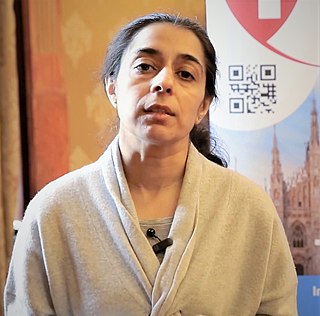
Sejal Saglani is a British medical researcher who is Professor and Head of the Inflammation, Repair and Development Section at the National Heart and Lung Institute. Her research considers wheeze and severe childhood asthma. She serves as an Honorary Consultant in Paediatric Respiratory Medicine at the Royal Brompton Hospital.

Interleukin 17F (IL-17F) is signaling protein that is in human is encoded by the IL17F gene and is considered a pro-inflammatory cytokine. This protein belongs to the interleukin 17 family and is mainly produced by the T helper 17 cells after their stimulation with interleukin 23. However, IL-17F can be also produced by a wide range of cell types, including innate immune cells and epithelial cells.
Clare Bryant is a British veterinary scientist and clinical pharmacologist who is a professor at the University of Cambridge. She specialises in innate immunity. Bryant is a Fellow of Queens' College, Cambridge and of the British Pharmacological Society.
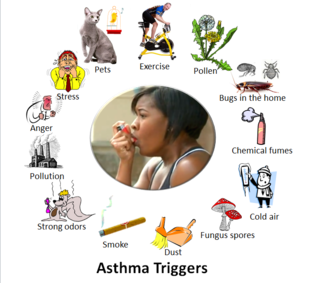
Asthma triggers are factors or stimuli that provoke the exacerbation of asthma symptoms or increase the degree of airflow disruption, which can lead to an asthma attack. An asthma attack is characterized by an obstruction of the airway, hypersecretion of mucus and bronchoconstriction due to the contraction of smooth muscles around the respiratory tract. Its symptoms include a wide range of manifestations such as breathlessness, coughing, a tight chest and wheezing.
References
- 1 2 Clare Lloyd publications indexed by Google Scholar
- 1 2 3 4 5 6 7 "Professor Clare Lloyd". imperial.ac.uk. Imperial College London. Retrieved 2018-12-16.
- ↑ ORCID 0000-0001-8977-6726
- ↑ Gutierrez-Ramos, Jose-Carlos; Gearing, David; Coyle, Anthony J.; Proudfoot, Amanda E. I.; Powers, Christine A.; Dussault, Barry; Yu, Gary; Jia, Gui-Quan; Lloyd, Clare M. (1999). "Mouse Monocyte-Derived Chemokine Is Involved in Airway Hyperreactivity and Lung Inflammation". The Journal of Immunology. 163 (1): 403–411. doi: 10.4049/jimmunol.163.1.403 . ISSN 1550-6606. PMID 10384142.
- ↑ Lloyd, Clare M.; Delaney, Tracy; Nguyen, Trang; Tian, Jane; Martinez-A, Carlos; Coyle, Anthony J.; Gutierrez-Ramos, Jose-Carlos (2000). "Cc Chemokine Receptor (Ccr)3/Eotaxin Is Followed by Ccr4/Monocyte-Derived Chemokine in Mediating Pulmonary T Helper Lymphocyte Type 2 Recruitment after Serial Antigen Challenge in Vivo". The Journal of Experimental Medicine. 191 (2): 265–274. doi:10.1084/jem.191.2.265. ISSN 0022-1007. PMC 2195756 . PMID 10637271.
- 1 2 Lloyd, Clare (2002). "Chemokines in allergic lung inflammation". Immunology. 105 (2): 144–154. doi:10.1046/j.1365-2567.2002.01344.x. ISSN 0019-2805. PMC 1782646 . PMID 11872089.
- ↑ "Prof. Clare Lloyd | Asthma UK Centre". asthma-allergy.ac.uk. Retrieved 2018-12-16.
- ↑ "Home | 3i Consortium - Wellcome Trust Sanger Institute". immunophenotype.org. Retrieved 2018-12-16.
- ↑ "Wheezing and Asthma: Earlier Diagnosis and Treatment | Action Medical Research | Children's Charity". action.org.uk. 2013-04-10. Archived from the original on 2018-12-17. Retrieved 2018-12-16.
- ↑ "Lungs". Wellcome Collection. Retrieved 2018-12-16.
- ↑ Lloyd, Clare M.; Saglani, Sejal (2010). "Asthma and allergy: The emerging epithelium". Nature Medicine . 16 (3): 273–274. doi:10.1038/nm0310-273. PMC 3380503 . PMID 20208514.
- ↑ Lloyd, Clare M.; Hawrylowicz, Catherine M. (2009). "Regulatory T Cells in Asthma". Immunity. 31 (3): 438–449. doi:10.1016/j.immuni.2009.08.007. ISSN 1074-7613. PMC 3385348 . PMID 19766086.
- ↑ Lloyd, Clare M.; Phimister, Elizabeth G.; Harker, James A. (2018). "Epigenetic Control of Interleukin-9 in Asthma" (PDF). New England Journal of Medicine. 379 (1): 87–89. doi:10.1056/NEJMcibr1803610. hdl: 10044/1/61609 . ISSN 0028-4793. PMID 29972761. S2CID 49651778.
- ↑ "Structure and key people". Imperial College London. Retrieved 2018-12-16.
- ↑ "People – LLOYD LAB" . Retrieved 2018-12-16.
- ↑ "Honours and Memberships - Professor Clare Lloyd". imperial.ac.uk. Retrieved 2018-12-16.
- ↑ Uwadiae, Faith I.; Pyle, Chloe J.; Walker, Simone A.; Lloyd, Clare M.; Harker, James A. (2018). "Targeting the ICOS/ICOS-L pathway in a mouse model of established allergic asthma disrupts T follicular helper cell responses and ameliorates disease". Allergy. 74 (4): 650–662. doi:10.1111/all.13602. ISSN 1398-9995. PMC 6492018 . PMID 30220084.
- 1 2 3 "Professor Clare Lloyd on being Vice Dean (Institutional Affairs)". FoM Staff Blog. 2017-11-27. Retrieved 2018-12-16.
- ↑ "Advisory Board". Science | AAAS. 2018-01-31. Retrieved 2018-12-18.
- ↑ "About the Editors | Mucosal Immunology". www.nature.com. Retrieved 2018-12-18.
- ↑ "European Journal of Immunology". onlinelibrary.wiley.com. doi:10.1002/(ISSN)1521-4141. hdl:2027.42/37955. S2CID 250212720 . Retrieved 2018-12-18.
- ↑ "Clare Lloyd | Royal Society". royalsociety.org. Retrieved 2018-12-18.
- ↑ "Professor Clare Lloyd | The Academy of Medical Sciences". acmedsci.ac.uk. Retrieved 7 March 2020.